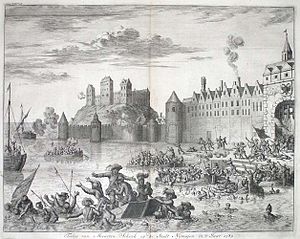Assault on Nijmegen (1589)
| Assault on Nijmegen | |||||||
|---|---|---|---|---|---|---|---|
| Part of the Cologne War | |||||||
|
In the failed assault, Martin Schenck, Commander, drowned in the Rhine River at Nijmegen |
|||||||
|
|||||||
| Belligerents | |||||||
|
|
|
||||||
| Commanders and leaders | |||||||
| Martin Schenck von Nydeggen † | Nijmegen Garrison | ||||||
| Strength | |||||||
| 200-250 men | City garrison (@ 50), plus civilians | ||||||
| Casualties and losses | |||||||
| 50% | < 20 | ||||||
The Assault on Nijmegen occurred on the night of 10 August 1589, involving troops of the mercenary Martin Schenck von Nydeggen against the small garrison and some citizens at the city of Nijmegen.
Located at the confluence of the Waal and Rhine rivers, Nijmegen was strategically important to the defense of the Dutch provinces and the Electorate of Cologne. Planning to take the city by surprise, Schenck and his troops would then reinforce the city, provision it and prepare it for siege by troops of Alexander Farnese, Duke of Parma.
In the attack, Schenck and his soldiers tried to enter the city from barges on the Waal river. Some of the barges floated past the rendezvous point, and landed further down river. Others deposited Schenck and his men at a house where a wedding party meant the residence was packed with people. In the abortive battle, Schenck and many of his men drown in the river. It was the second to last action of the Cologne War.
The Cologne War was the first major test of the 1555 religious Peace of Augsburg's and the principle of ecclesiastical reservation. It was triggered by the 1582 conversion of the Archbishop-Prince Elector of Cologne, Gebhard Truchsess von Waldburg, to Calvinism, his subsequent marriage to Agnes von Mansfeld-Eisleben in 1583, and his declaration of religious parity for Protestants and Catholics in the electorate. When Gebhard refused to relinquish the ecclesiastical see, the Cathedral chapter elected a competing archbishop, Ernst of Bavaria.
For the first two years, the competing archbishops fought to a standstill. Both had external help: Ernst's oldest brother, Wilhelm V, Duke of Bavaria provided soldiers and funds, and his second eldest brother, Ferdinand, commanded the small army in his name, and Gebhard's brother, Karl Truchsess von Waldburg and several Protestant supporters within the Electorate provided both soldiers and funds. In the immediate months of the war's outbreak, the Oberstift campaign resulted in Gebhard's loss of several important cities and citadels, which eventually changed hands several times in the course of the war. In the 1585–86 campaigns, Dutch, Flemish and English mercenaries had augmented his force, but he never attracted significant support from the other German princes, principally because he was a Calvinist and they were Lutherans. The Dutch had offered moderate help, recognizing the linkage between his cause and their own independence from Catholic Spain. Conversely, Alexander Farnese, Duke of Parma and commander of Philip II of Spain's army in Flanders also recognized the linkage between Ernst's cause and his own. A series of Catholic bridgeheads on the Rhine would enable him to move his troops more easily around several of the strongholds opposing the re-establishment of Spanish control in the Netherlands. In 1585 and 1587, Ernst won several important victories, principally through the efforts of the Duke of Parma's army, and several of the German-Catholic counts, such as Karl von Mansfeld.
...
Wikipedia

